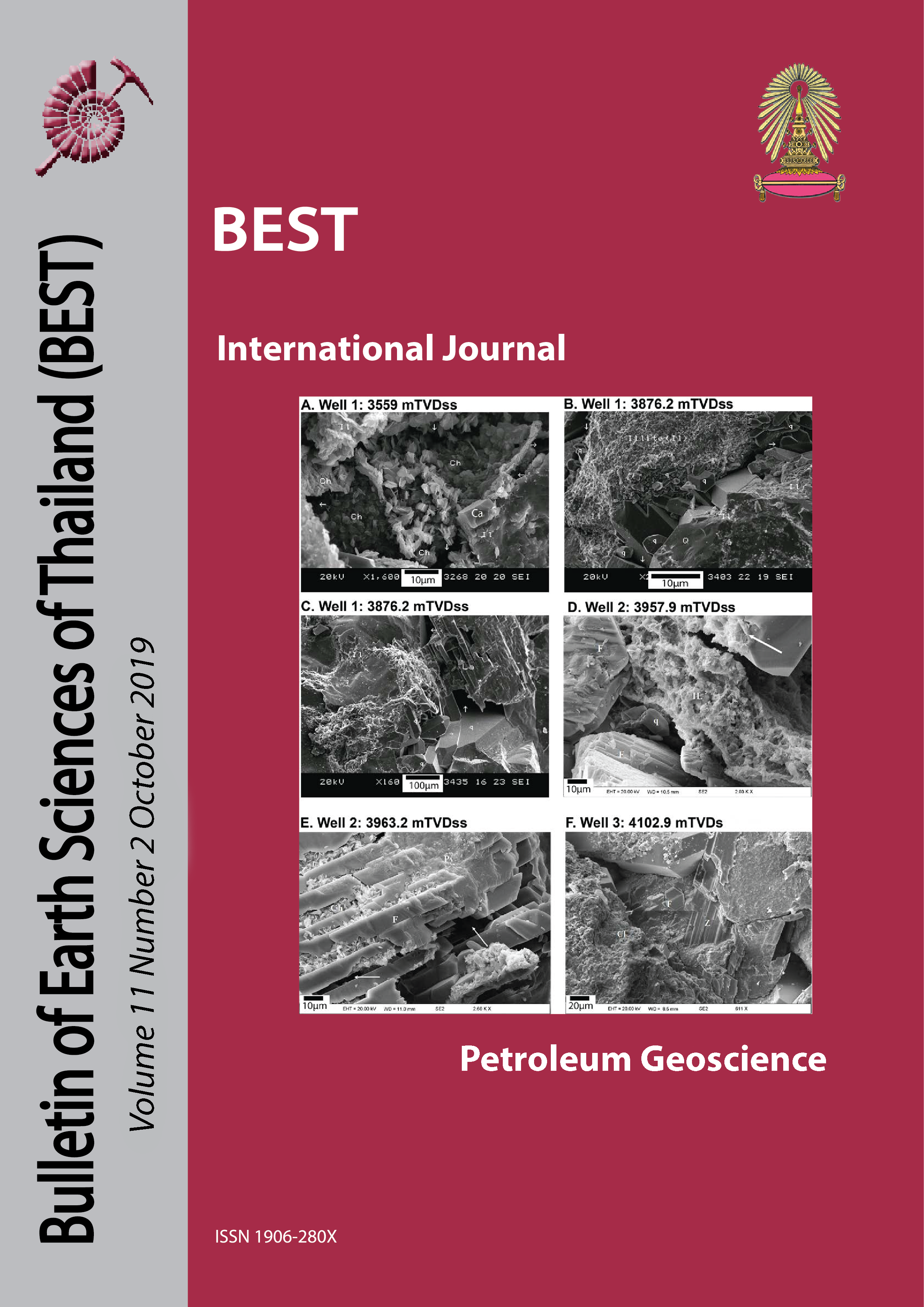SALT TECTONICS CONTROL ON RESERVOIR GEOMETRY, VOLVE FIELD, NORTH SEA
Main Article Content
Abstract
This study was undertaken to investigate mobile salt and its control on reservoir geometry in the Volve Field, North Sea by using 3D seismic and well data. During the Triassic – Cretaceous, structures and stratigraphy develop in the Volve Field, SW margins of Utsira High, North Sea, resulting in the formation of a minibasin and halokinesis of the Zechstein Supergroup. The subsequent continental, fluvial, deltaic and marine sediments were deposited into the accommodation space formed by salt movement. The movement of salt in combination with the rift-related fault system has complicated the distribution and geometry of the reservoirs. The Triassic minibasins developed because of the mobilization of Zechstein Supergroup, Upper Permian. Consequently, the series of Jurassic minibasins formed due to the collapse of the underlying salt ridges. Early Cretaceous reservoirs are slightly affected by salt withdrawal caused by high compaction. However, movement of salt was not related to the formation of Late Cretaceous reservoirs. The salt movement would have been related to: (a) the salt dissolution due to groundwater and changes in relative sea level, (b) differential erosion of salt bodies and Triassic-cored highs, (c) the salt withdrawal due to the extension resulting in high accommodation space and sediment loading leading to high compaction. The study gives the detailed insights into the structural evolution of the minibasin on the Volve Field and has implications for reservoir geometry and distribution of Zechstein salt within the North Sea rift systems and the development process of depositional system of reservoirs from Triassic to Cretaceous.
Article Details

This work is licensed under a Creative Commons Attribution-NonCommercial-NoDerivatives 4.0 International License.
Copyright © 2008 Department of Geology, Faculty of Science, Chulalongkorn University. Parts of an article can be photocopied or reproduced without prior written permission from the author(s), but due acknowledgments should be stated or cited accordingly.
References
Bjorlykke, K., 2016, Petroleum Geoscience From Sedimentary Environments to Rock Physics: Berlin, Springer Berlin.
Clark, J., J. Cartwright, and S. Stewart, 1999, Mesozoic dissolution tectonics on the West Central shelf, UK Central North Sea: Marine and Petroleum Geology, v. 16, no. 3, p. 283– 300, doi:10.1016/s0264-8172(98)00040-3.
Cockings, J. H., L. G. Kessler, T. A. Mazza, and L. A. Riley, 1992, Bathonian to mid-Oxfordian sequence stratigraphy of the South Viking Graben, North Sea: Geological Society, London, Special Publications, v. 67, no. 1, p. 65–105, doi:10.1144/gsl.sp.1992.067.01.04.
Davies, R. J., J. D. Turner, and J. R. Underhill, 2001, Sequential dip-slip fault movement during rifting: a new model for the evolution of the Jurassic trilete North Sea rift system: Petroleum Geoscience, v. 7, no. 4, p. 371– 388, doi:10.1144/petgeo.7.4.371.
Færseth, R. B., 1996, Interaction of PermoTriassic and Jurassic extensional fault-blocks during the development of the northern North Sea: Journal of the Geological Society, v. 153, no. 6, p. 931–944, doi:10.1144/gsjgs.153.6.0931.
Glennie, K. W., and J. R. Underhill, 1998, Origin, Development and Evolution of Structural Styles: Petroleum Geology of the Bulletin of Earth Sciences of Thailand North Sea, p. 42–84, doi:10.1002/9781444313413.ch2.
Jackson, C. A.-L., K. E. Kane, and E. Larsen, 2010, Structural evolution of minibasins on the Utsira High, northern North Sea; implications for Jurassic sediment dispersal and reservoir distribution: Petroleum Geoscience, v. 16, no. 2, p. 105–120, doi:10.1144/1354-079309-011.
Lyngsie, S., H. Thybo, and T. Rasmussen, 2006, Regional geological and tectonic structures of the North Sea area from potential field modelling: Tectonophysics, v. 413, no. 3-4, p. 147–170, doi:10.1016/j.tecto.2005.10.045.NPD, 2019: <http://factpages.npd.no/factpages/> (accessed April 1, 2019).
Pegrum, R. M., and T. E. Ljones, 1984, 15/9 Gamma Gas Field Offshore Norway, New Trap Type for North Sea Basin with Regional Structural Implications: AAPG Bulletin, v. 68, doi:10.1306/ad46143f-16f7-11d78645000102c1865d.
Phillips, T. B., C. A.-L. Jackson, R. E. Bell, and O. B. Duffy, 2017, Oblique reactivation of lithosphere-scale lineaments controls rift physiography - The upper crustal expression of the Sorgenfrei-Tornquist Zone, offshore southern Norway: Solid Earth Discussions, p. 1–42, doi:10.5194/se-2017-97.
Underhill, J. R., and M. A. Partington, 1993, Jurassic thermal doming and deflation in the North Sea: implications of the sequence stratigraphic evidence: Geological Society, London, Petroleum Geology Conference series, v. 4, no. 1, p. 337–345, doi:10.1144/0040337.
Warren, J. K., 2016, Evaporites: a geological compendium: Cham, Springer.
Zanella, E., Coward, M.P., & McGrandle, A. 2003. Structural Framework. In: Evans, D., Graham, C., Armour, A. & Bathurst, P. (eds) The Millennium Atlas: Petroleum Geology of the Central and Northern North Sea. Geological Society, London, 44–60.


